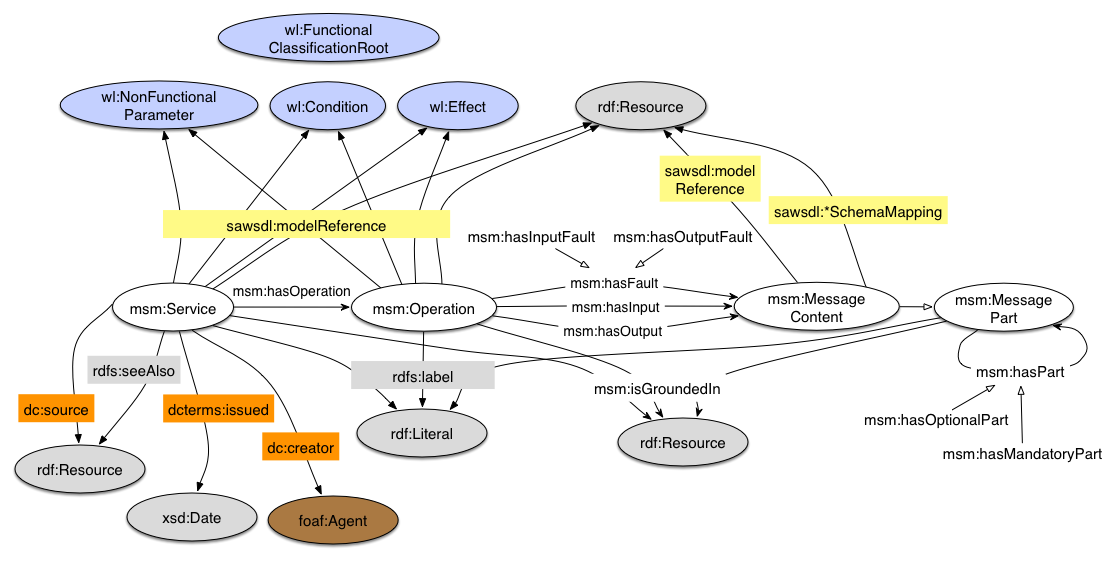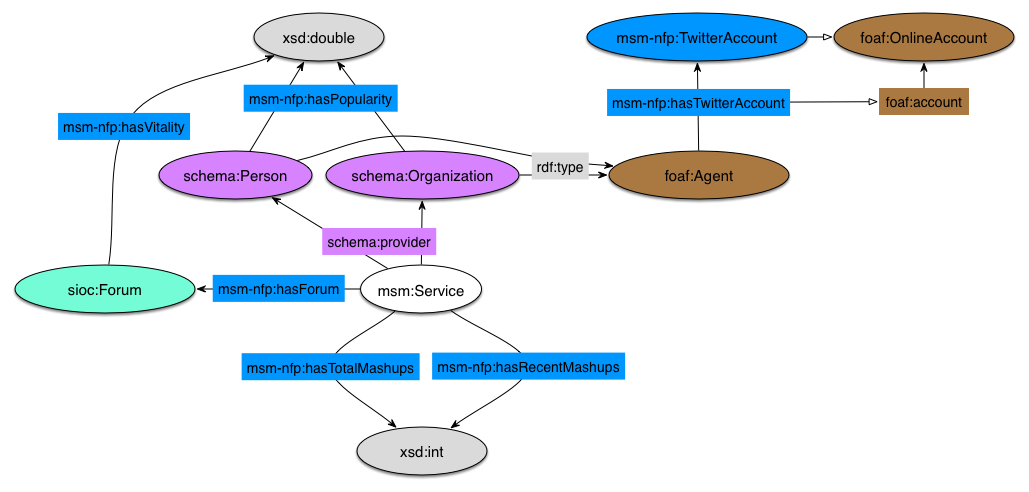Vocabularies Used by MSM4J
Minimal Service Model
In a nutshell, MSM is a simple RDF(S) integration ontology based on the principle of minimal ontological commitment; it captures the maximum common denominator between existing conceptual models for services. Thus, MSM does not aim to be yet another service model to bring further heterogeneity to the services landscape; it is instead an integration model at the intersection of existing formalisms, able to capture the core semantics of both Web services and Web APIs in a common model, homogeneously supporting publication and discovery.
Minimal Service Model, denoted by the msm namespace in the Figure below, defines msm:Services which have a number of Operations. Operations in turn have input, output and fault MessageContent descriptions. MessageContent may be composed of mandatory or optional MessageParts.

Driven by Semantic Web best practices, MSM builds upon existing vocabularies. The most recent version of MSM (v1.3), depicted in the figures, exploits the following vocabularies:
- SAWSDL, using the sawsdl namespace;
- WSMO-Lite, using the wl namespace;
- hRESTS, using the hr namespace;
- DC Terms, using the dc namespace;
- FOAF, using the foaf namespace;
In addition, MSM has some extensions that are modelled according to the minimal ontological commitment principle as well:
- MSM-WSDL, which provides the MSM grounding to WSDL descriptions;
- MSM-Swagger, which provides the MSM grounding to JSON descriptions defined according to Swagger specification;
- MSM-NFP, which provides useful Non-Functional Properties (NFPs) of services to support Web developers, such as service provider information and social media channels.
New features coming for MSM 1.3
The next version of MSM will contain two main novelties:
- the definition of a generic msm:isGroundedIn property;
- the introduction of the msm:hasFault property.
We shall be releasing this version soon.
The msm:isGroundedIn property enables to capture the grounding of elements of service descriptions defined by other models, such as WSDL, SWAGGER, WSMO and OWL-S. In other terms, this property allows us to bind any other kind of structured service description to MSM elements, with the aim to make MSM an agnostic model for semantic annotation, leaving the technical invocation details to other specifications.
The msm:hasFault property is introduced to define generic operation faults that can not be strictly related to input or output issues. As far we know the only specification which distinguishes between input and output fault is WSDL 2.0. All others simply refer to faults. We have retained msm:hasInputFault and msm:hasOutputFault as subproperties of msm:hasFault for compatibility reasons with WSDL and older MSM descriptions but now recommend using the more generic term msm:hasFault. msm:hasInputFault and msm:hasOutputFault are now tagged as archaic terms according to the Term-centric Semantic Web Vocabulary Annotations and their removal may be considered in the future.
SAWSDL
The SAWSDL vocabulary provides three properties, namely sawsdl:modelReference, sawsdl:liftingSchemaMapping and sawsdl:loweringSchemaMapping. These properties enable one to link existing descriptions to semantic models (modelReference) as to scripts able to transform diverse serialisations into their semantic counter part and vice versa.
WSMO-Lite
The WSMO-Lite vocabulary completes MSM by providing classes for describing the main service semantics and by supplying type information to the generic model references. In particular, WSMO-Lite captures non-functional semantics through the concept of wl:NonfunctionalParameter, and functional semantics via the concepts wl:Condition, wl:Effect, and wl:FunctionalClassificationRoot.
hRESTS
hRESTS on the other hand provides basic support for capturing grounding information necessary for Web APIs. This vocabulary, see Figure below, therefore covers aspects such as URL templates, HTTP methods used, etc

The current version of hRESTS (v1.2) exploits terms from the HTTP RDF vocabulary to define the HTTP methods used by operations.
MSM-WSDL
MSM-WSDL provides one simple property, msm-wsml:isGroundedIn, which enables us to capture the grounding of elements of a service description into the actual WSDL element that defines it. This property essentially provides us back and forth navigation from MSM service descriptions into WSDL files as necessary to carry out invocation for example.
For the current MSM-WSDL version (v0.2), the WSDL element should be specified according to a WSDL 1.1 or 2.0 IRI-references syntax defined by a XPointer expression.

MSM-NFP
MSM-NFP is a MSM extension that aims to support the description of basic NFPs. The current version of MSM-NFP (v0.1) focuses on the definition of properties which provide relevant information for developers which integrate services in their own applications.
To inform developers of the usage of a service, msm-nfp:hasTotalMashups and msm-nfp:hasRecentMashups properties has been defined. The two properties respectively define the total number and the recent amount of mashups in which a Web API is a component.
A Web API can have a forum to support developer issues. This information can be specified through the msm-nfp:hasForum property, which has the sioc:Forum class, from the SIOC vocabulary, as range. MSM-NFP specifies also a measurement of the forum vitality, as average of daily users that post messages, through the msm-nfp:hasVitality. This measure can be useful for developers to figure out the promptness of the forum community to support users issues.
Measures of service provider popularity can be specified by the msm-nfp:hasPopularity property as a numeric value. The schema:Organization and schema:Person classes, defined by the Schema.org vocabulary, are the domain of the msm-nfp:hasPopularity property. These two classes allow us to define a service provider which is associated with a service through the schema:provider property.
A provider, defined as a foaf:Agent, can have a Twitter account as a means to provide updates about his Web APIs. A Twitter account is an instance of the msm-nfp:TwitterAccount class (subclass of foaf:OnlineAccount) which is a associated to a provider by the msm-nfp:hasTwitterAccount property (subproperty of foaf:account).

Others
Both DC Terms and FOAF provide general support to capture metadata such as a textual description, the creator of a service description, etc. SIOC vocabulary provides the main concepts and properties required to describe information from online communities, such as wikis, weblogs and forums. Finally, Schema.org is a collection of terms that webmasters can use to markup their pages, which is introduced by Bing, Google and Yahoo! to improve the display of search engine results.
References
For convenience all RDF/S vocabularies used are included within the sources of MSM4J, see module msm4j-vocabulary. Additionally we provide herein information about versions, namespaces, and links to the vocabularies used for your reference.
| Vocabulary | Namespace | Link to Vocabulary |
|---|---|---|
| Minimal Service Model | msm | http://iserve.kmi.open.ac.uk/ns/msm |
| WSMO-Lite | wl | http://www.wsmo.org/ns/wsmo-lite |
| hRESTS | hr | http://iserve.kmi.open.ac.uk/ns/hrests |
| MSM-WSDL | msm-wsdl | http://iserve.kmi.open.ac.uk/ns/msm-wsdl |
| MSM-NFP | msm-nfp | http://iserve.kmi.open.ac.uk/ns/msm-nfp |
| DC Terms | dc | http://purl.org/dc/elements/1.1/ |
| FOAF | foaf | http://xmlns.com/foaf/0.1/ |
| SIOC | sioc | http://rdfs.org/sioc/ns# |
| Schema.org | schema | http://schema.org/ |


